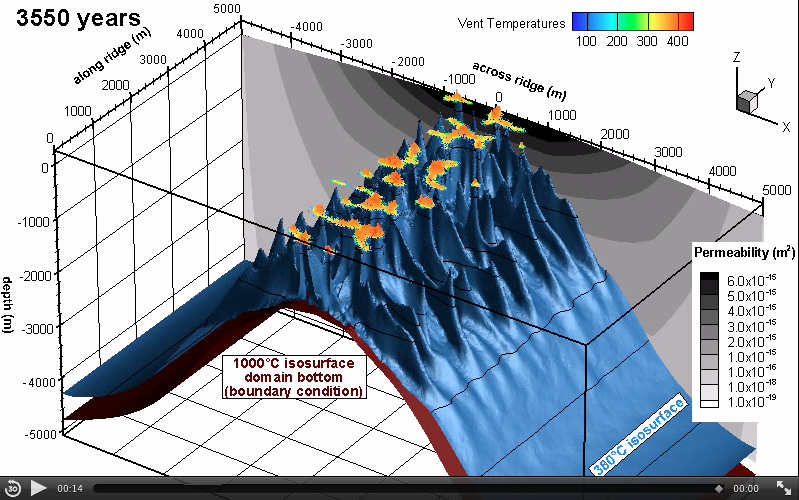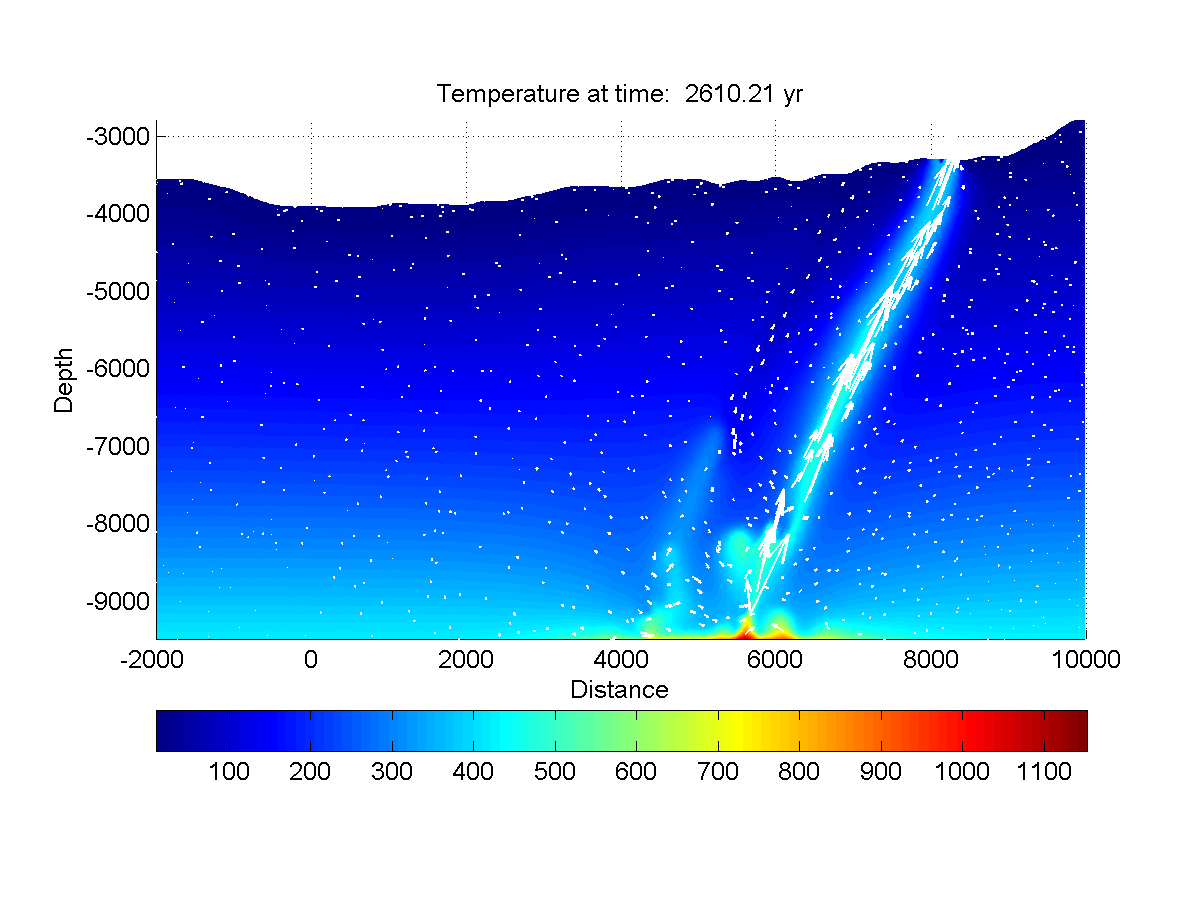3D numerical simulation of hydrothermal convection at the East Pacific Rise
Numerical modeling of hydrothermal systems
The discovery of hydrothermal black smoker systems at mid-ocean ridges in the late 1970s was one of the most exciting achievements in oceanography – not least because of its importance for different fields of geosciences. Hydrothermal systems efficiently mine heat from the young ocean crust, thermal springs at the seafloor host unique ecosystems in extreme environmental conditions and commercially interesting high-quality ore deposits form as a byproduct of hydrothermal venting.
Numerical modeling is an excellent research tool for the investigation of hydrothermal processes in the oceanic crust. Models gain a lot when combined with and compared to data from direct field methods. It is possible to model the long-term evolution of hydrothermal systems which gives valuable time series. We model hydrothermal fluid flow in the subsurface as compressible 2D and 3D porous flow using the finite element method. Geophysical field data as e.g. bathymetry and seismicity is included in the models if possible. Some of the questions we are addressing are:
· What is the major control on hydrothermal vent site position on the seafloor?
· How can high temperature hydrothermal fields be active in off-axis regions?
· What is influence of faults and fractures on hydrothermal fluid flow?
· Where do we find hydrothermal recharge cells, across- or along-axis?
· What are the effects of phase separation on submarine hydrothermal fluid flow?
We have put significant effort into the implementation of multiphase flow. Moreover it has become increasingly clear that hydrothermal systems are much more complex than suggested by pure thermodynamics. Near-critical and critical phenomena have first order control on mass and energy transport, so that real natural systems can only be understood if thermodynamics and transport models are combined.
Contact:
References
Theissen-Krah, S., Rüpke, L. H., and Hasenclever, J. (2016) Modes of crustal accretion and their implications for hydrothermal circulation: Geophysical Research Letters, v. 43, no. 3, p. 2015GL067335.
Andersen, C. S., Rüpke, L., Hasenclever, J., Grevemeyer, I. and Petersen, S. (2015) Fault geometry and permeability contrast control vent temperatures at the Logatchev 1 hydrothermal field, Mid-Atlantic Ridge Geology, 43 (1). pp. 51-54. DOI 10.1130/G36113.1. Item availability may be restricted.
Hasenclever, J., Theissen-Krah, S., Rüpke, L. H., Morgan, J. P., Iyer, K., Petersen, S. and Devey, C. W.(2014) Hybrid shallow on-axis and deep off-axis hydrothermal circulation at fast-spreading ridges Nature, 508 (7497). pp. 508-512. DOI 10.1038/nature13174. Item availability may be restricted.
Bani Hassan, N., Iyer, K., Rüpke, L. H. and Borgia, A. (2012) Controls of bathymetric relief on hydrothermal fluid flow at mid-ocean ridges Geochemistry Geophysics Geosystems, 13 . Q05002. DOI 10.1029/2012GC004041. Item availability may be restricted.
Theissen-Krah, S., Iyer, K., Rüpke, L. and Morgan, J. P. (2011) Coupled mechanical and hydrothermal modeling of crustal accretion at intermediate to fast spreading ridges Earth and Planetary Science Letters, 311 (3-4). pp. 275-286. DOI 10.1016/j.epsl.2011.09.018. Item availability may be restricted.
Iyer, K., Rüpke, L. and Phipps Morgan, J. (2010) Feedbacks between mantle hydration and hydrothermal convection at ocean spreading centers Earth and Planetary Science Letters, 296 (1/2). pp. 34-44. DOI 10.1016/j.epsl.2010.04.037. Item availability may be restricted.




